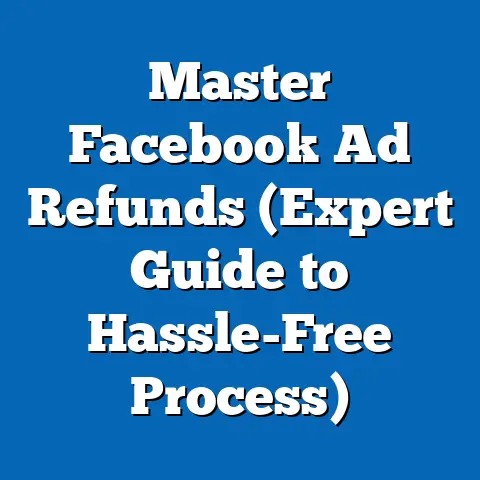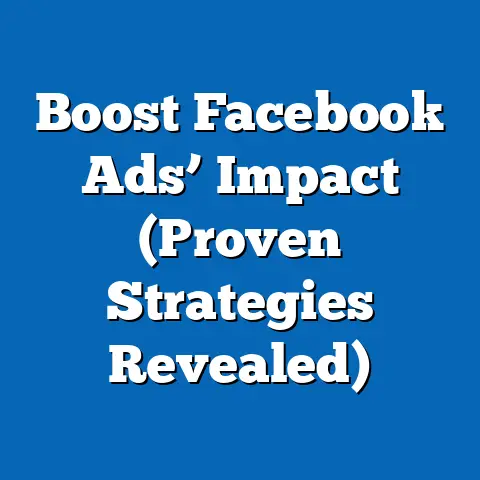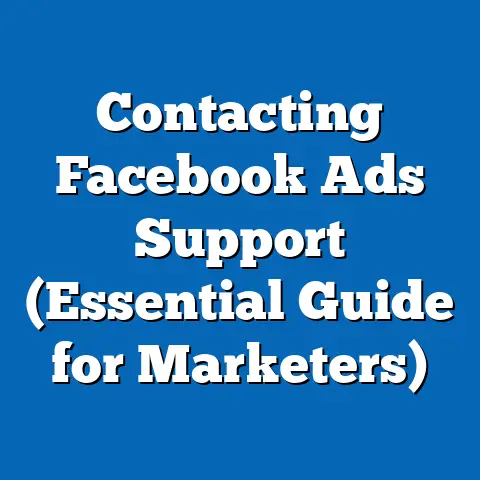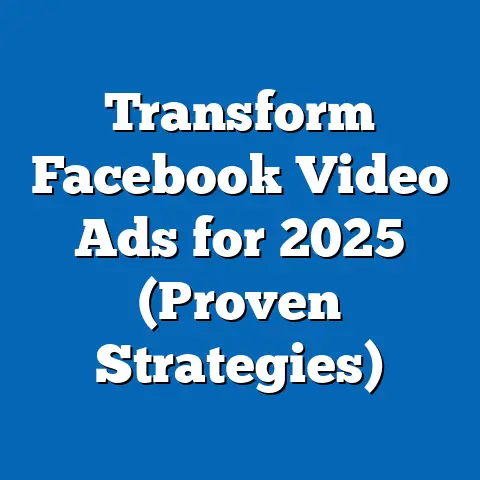Maximize CPA with Facebook Ads (Proven Strategies)
In today’s world, consumers are increasingly aware of their environmental footprint. They’re actively seeking out brands that share their values and prioritize sustainability. This shift in consumer behavior presents a unique opportunity for eco-conscious businesses. But how do you effectively reach this audience and drive conversions without breaking the bank? The answer lies in strategic Facebook advertising. I’ve spent years helping brands navigate the complexities of Facebook Ads, and I’ve seen firsthand how a tailored approach can significantly reduce your Cost Per Acquisition (CPA), especially when targeting environmentally aware consumers.
Understanding CPA and Its Importance
Cost Per Acquisition (CPA) is a critical metric in digital marketing. Simply put, it’s the cost you incur to acquire one paying customer. For Facebook Ads, CPA represents the amount you spend to get someone to take a desired action, such as making a purchase, signing up for a newsletter, or downloading a resource.
Why is CPA so important? Well, it directly impacts your profitability. A high CPA can quickly eat into your margins, making your advertising efforts unsustainable. On the other hand, a low CPA means you’re efficiently acquiring customers, maximizing your return on investment (ROI).
For eco-conscious brands, the importance of CPA is amplified. Often, these brands operate in niche markets and may face higher production costs due to sustainable sourcing and ethical practices. Therefore, keeping CPA low is essential for maintaining competitiveness and ensuring long-term viability. It allows you to reinvest in your mission, further develop sustainable products, and expand your reach without compromising your values.
Think of it this way: CPA is the heartbeat of your Facebook Ads strategy. By closely monitoring and optimizing it, you can ensure your campaigns are not only effective but also financially sustainable.
Takeaway: Understand CPA as a key performance indicator (KPI) that directly impacts your profitability and sustainability as an eco-conscious brand.
Audience Targeting for Eco-Conscious Brands
One of the most powerful aspects of Facebook Ads is its ability to target specific audiences. For eco-conscious brands, precise audience targeting is not just beneficial; it’s essential for maximizing CPA. You need to reach the right people – those who are genuinely interested in sustainability and likely to become loyal customers.
Here’s how to leverage Facebook Ads Manager to identify and reach your ideal eco-conscious audience:
- Demographic and Interest-Based Targeting: Start by defining your ideal customer profile. What are their demographics (age, gender, location, education)? What are their interests? Facebook allows you to target users based on these criteria. For example, you can target individuals interested in “organic food,” “sustainable living,” “environmental conservation,” or specific eco-friendly brands. I once worked with a sustainable clothing brand that saw a 30% reduction in CPA simply by refining their targeting to include users interested in ethical fashion and fair trade.
- Custom Audiences: Custom audiences allow you to upload your existing customer data (email lists, phone numbers) to Facebook. This enables you to target individuals who have already shown interest in your brand. You can also create custom audiences based on website visitors or users who have interacted with your Facebook page or Instagram profile. This is incredibly effective for retargeting (more on that later).
- Lookalike Audiences: This is where the magic truly happens. Lookalike audiences allow you to create new audiences based on the characteristics of your existing customers. Facebook analyzes your custom audiences and identifies users with similar interests, behaviors, and demographics. This is a powerful way to expand your reach and find new customers who are likely to be interested in your eco-conscious products or services.
- Behavioral Targeting: Facebook also allows you to target users based on their online behavior. For eco-conscious brands, this means targeting individuals who have shown interest in sustainable products, made donations to environmental organizations, or participated in eco-friendly activities. This level of granularity can significantly improve your ad relevance and reduce your CPA.
Real-World Example: I worked with a company selling bamboo toothbrushes. Initially, they were targeting a broad audience interested in “dental hygiene.” While they saw some conversions, their CPA was high. By refining their targeting to include users interested in “eco-friendly products,” “sustainable living,” and “zero waste,” they saw a dramatic decrease in CPA and an increase in conversion rates.
Takeaway: Precise audience targeting is crucial for maximizing CPA. Utilize demographic, interest-based, custom, lookalike, and behavioral targeting to reach your ideal eco-conscious audience.
Crafting Compelling Ad Copy and Creative
Once you’ve identified your target audience, you need to create ad copy and creative that resonates with their values and captures their attention. For eco-conscious consumers, authenticity and transparency are paramount. They want to know that your brand is genuinely committed to sustainability, not just greenwashing.
Here are some key considerations for crafting compelling ad copy and creative:
- Authenticity and Transparency: Be honest and upfront about your brand’s sustainability efforts. Share your mission, values, and the specific steps you’re taking to reduce your environmental impact. Avoid making exaggerated claims or misleading statements. Eco-conscious consumers are savvy and can easily spot inauthenticity.
- Eco-Friendly Certifications and Practices: If your products or practices are certified by reputable organizations (e.g., Fair Trade, USDA Organic, B Corp), highlight these certifications in your ad copy and creative. This adds credibility and demonstrates your commitment to sustainability. For example, you might say, “Certified organic cotton grown using sustainable farming practices.”
- Storytelling: Connect with your audience on an emotional level by telling stories about your brand’s journey, your commitment to sustainability, and the impact you’re making. Share stories about the people behind your brand, the communities you’re supporting, and the positive environmental outcomes you’re achieving. Storytelling humanizes your brand and makes it more relatable.
- Visually Appealing Creatives: Use high-quality images and videos that reflect your brand’s values and showcase your sustainable practices. Consider using natural lighting, earthy tones, and visuals that highlight the beauty of nature. If possible, show your products in action, demonstrating their functionality and sustainability. I’ve found that user-generated content (photos and videos created by your customers) can be particularly effective in building trust and authenticity.
Examples of Effective Ad Copy:
- “Shop our collection of organic cotton clothing, made with sustainable practices and designed to last. Join us in creating a more ethical and environmentally friendly fashion industry.”
- “We’re committed to reducing our carbon footprint. That’s why we use recycled packaging and donate a portion of our profits to environmental conservation efforts. Shop now and make a difference.”
- “Discover our range of plant-based skincare products, formulated with natural ingredients and cruelty-free practices. Nourish your skin and protect the planet.”
Takeaway: Craft ad copy and creative that are authentic, transparent, and visually appealing. Highlight your brand’s sustainability efforts, use storytelling to connect with your audience, and showcase your products in a way that reflects your values.
Utilizing Retargeting Strategies
Retargeting is a powerful technique for maximizing CPA on Facebook Ads. It allows you to reconnect with potential customers who have previously interacted with your brand but haven’t yet made a purchase. For eco-conscious brands, retargeting can be particularly effective because it reinforces your message and builds trust over time.
Here’s how to utilize retargeting strategies effectively:
- Website Visitors: Create a custom audience of people who have visited your website. You can then target these users with ads that showcase your best-selling products, highlight your sustainability practices, or offer a special discount. For example, if someone viewed a specific product page but didn’t add the item to their cart, you can retarget them with an ad featuring that product and a compelling call to action (e.g., “Shop Now and Get 10% Off!”).
- Social Media Engagers: Create a custom audience of people who have interacted with your Facebook page or Instagram profile. This includes users who have liked, commented on, or shared your posts, watched your videos, or sent you a message. You can then retarget these users with ads that promote your latest products, share behind-the-scenes content, or invite them to join your email list.
- Tailored Ads: When retargeting, it’s crucial to create ads that are tailored to the specific audience you’re targeting. For example, if you’re retargeting website visitors who viewed a specific product page, your ad should feature that product and highlight its benefits. If you’re retargeting social media engagers, your ad can be more conversational and focus on building brand awareness.
- Psychological Impact: Retargeting works because it leverages the psychological principle of familiarity. People are more likely to trust and purchase from brands they’ve seen before. By repeatedly showing your ads to potential customers, you’re building brand recognition and increasing the likelihood of a conversion. In the context of eco-consciousness, retargeting can also reinforce your brand’s commitment to sustainability, further solidifying your position in the minds of consumers.
Example: A customer visits your website and views a page about your sustainable coffee beans. They leave without making a purchase. A few days later, they see a Facebook ad featuring your coffee beans, highlighting their organic certification and ethical sourcing practices. The ad also includes a special offer: “Get 15% off your first order!” This retargeting ad is more likely to convert the customer than a generic ad because it’s tailored to their specific interests and provides an incentive to purchase.
Takeaway: Utilize retargeting strategies to reconnect with potential customers who have previously interacted with your brand. Create tailored ads that highlight your sustainability practices and offer compelling incentives to purchase.
Monitoring and Analyzing Campaign Performance
The final piece of the puzzle is monitoring and analyzing your Facebook Ad campaign performance. This is essential for identifying what’s working, what’s not, and making informed decisions to optimize your CPA.
Here are some key metrics to monitor:
- Click-Through Rate (CTR): This is the percentage of people who see your ad and click on it. A high CTR indicates that your ad copy and creative are resonating with your target audience.
- Conversion Rate: This is the percentage of people who click on your ad and complete a desired action (e.g., make a purchase, sign up for a newsletter). A high conversion rate indicates that your landing page and overall customer experience are effective.
- Cost Per Acquisition (CPA): As we’ve discussed, this is the cost you incur to acquire one paying customer. This is the ultimate metric for measuring the effectiveness of your Facebook Ad campaigns.
Here are some tools and techniques for analyzing ad performance:
- Facebook Ads Manager: This is your primary tool for monitoring and analyzing your Facebook Ad campaigns. It provides detailed data on your ad performance, including CTR, conversion rate, CPA, and other key metrics.
- A/B Testing: A/B testing allows you to compare different versions of your ads to see which performs best. You can test different ad copy, creative, targeting options, and landing pages. This is a powerful way to optimize your campaigns and improve your CPA. I always recommend testing one element at a time to accurately determine what’s driving the results.
- Customer Feedback: Don’t underestimate the value of customer feedback. Ask your customers what they think of your ads, your products, and your overall brand experience. This can provide valuable insights into what’s working and what’s not.
Example: You’re running two different Facebook Ad campaigns to promote your sustainable clothing line. Campaign A targets users interested in “organic fashion,” while Campaign B targets users interested in “eco-friendly products.” After a week, you analyze the results and find that Campaign A has a higher CTR and conversion rate than Campaign B. This indicates that targeting users interested in “organic fashion” is more effective for your brand. You can then allocate more of your budget to Campaign A and continue to optimize it based on the data you’re collecting.
Takeaway: Monitor and analyze your Facebook Ad campaign performance regularly. Track key metrics, use A/B testing to optimize your ads, and gather customer feedback to refine your strategies.
Conclusion
Maximizing CPA with Facebook Ads for eco-conscious brands requires a strategic and data-driven approach. By understanding your target audience, crafting compelling ad copy and creative, utilizing retargeting strategies, and monitoring your campaign performance, you can effectively connect with your ideal customers, drive conversions, and contribute to a more sustainable future.
Remember, authenticity and transparency are key. Eco-conscious consumers are looking for brands that genuinely share their values and are committed to making a positive impact on the planet. By aligning your marketing efforts with your sustainable practices, you can not only drive sales but also build a loyal customer base that supports your mission.
Don’t be afraid to experiment and test different strategies. The Facebook Ads platform is constantly evolving, so it’s important to stay up-to-date on the latest best practices and adapt your approach accordingly. By continuously learning and optimizing, you can ensure your Facebook Ad campaigns are not only effective but also sustainable in the long run.
Now, go forth and create Facebook Ads that resonate with your audience, drive conversions, and contribute to a more sustainable world!






